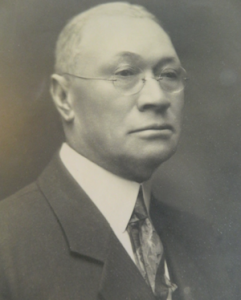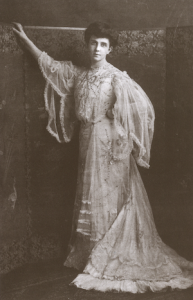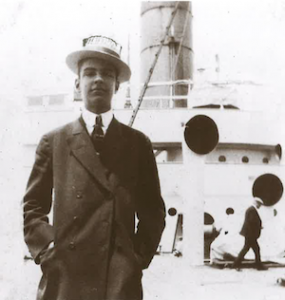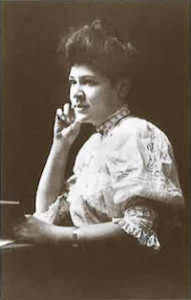Note that this episode and showcase were created in collaboration with The Alonzo F. and Norris B. Herndon Foundation (http://www.herndonhome.org/).
A Short History of The Herndon Home
Diamond Hill, A Planned Community
The elegant Herndon Home is located on Diamond Hill, a site of about sixty acres on the highest elevation in the City of Atlanta. This acreage was purchased by Atlanta University with core funding from the Freedman’s Bureau with the idea of creating a model family-oriented community for African American elites–leaders in education and other professions; leaders in business and politics; as well as community leaders. This move was very forward-looking with regard to developing and sustaining the viability of African Americans in the City of Atlanta generally, but of particular relevance for the development of the neighborhoods that surrounded what was evolving by that point into a distinctive conclave for higher education for African Americans. By 1893 when Alonzo and Adrienne Herndon were married, this area had already become home, not only to Atlanta University, but also to the Atlanta Baptist College (which later became Morehouse College) and the Atlanta Baptist Female Seminary (which later became Spelman College). Joining this group a few years later would be Morris Brown College, Clark College, and the Interdenominational Seminary, and ultimately the Morehouse School of Medicine. In 1893, however, the creation of such communities for African Americans constituted a critical resource since during this era discriminatory practices against African Americans were thriving and they were systematically denied the privilege of purchasing property in areas of the city deemed for whites only. The Herndon family, as exemplary of African American elite of their day, built their home at the top of the Diamond Hill ridgeline.
A Description of the Home
The Herndon Home was built between 1908 and 1910 as the residence of the Alonzo F. Herndon family, one of the most prominent African American families in the City of Atlanta. It remained the family residence until Norris B. Herndon, the only child in the family, died on June 7, 1977.
Architecturally, the Herndon Home is a two-story, 15-room mansion built in the Beaux Arts Classical style. It was designed by Adrienne McNeil Herndon (Alonzo Herndon’s first wife). Herndon functioned himself as the general contractor, and they employed African American craftsmen and carpenters to construct the magnificent structure under their careful oversight and management. On the exterior, it is multi-colored brick with a two-story entry portico supported by Corinthian columns, and it has one-story porches on each side. It has a flat roof that functions as an open terrace, designed by Adrienne, in recognition of her artistic interests as a professor of drama and elocution at Atlanta University, as a performance space. The interior displays an elaborately done eclectic style, including everything from Neo-classical to Renaissance Revival to Rococo features. It incorporates wood, stone, and plaster materials, and on the walls of the first floor walls are murals depicting scenes from the herndon family history.
At the turn of the twentieth century, the Herndon Home was deemed a remarkable structure, made even more remarkable by its ownership in the segregated South by African Americans. It was noted especially for its rooftop terrace with its spectacular panoramic views of downtown Atlanta. With ongoing urban change, however, this view has been increasingly compromised by encroaching developments. Currently, the view is dominated by the most recent change to the sightline, the Mercedes-Benz Stadium, built for the Atlanta Falcons and opened on August 26, 2017.
After Norris Herndon’s death in 1977, the family fortune went to the Alonzo F. and Norris B. Herndon Foundation, Inc., the organization that continues to maintain, care for, and operate the home, as well as to continue the social, cultural, and community commitments of the Herndon family. The Foundation opened the Herndon Home to tours in 1983 and continues its management as a museum. In 2000, it was designated a National Historic Landmark. It pays tribute to:
- The rise of Alonzo F. Herndon from slavery to business success, local and national leadership, and economic affluence.
- The artistic and academic accomplishments of Adrienne McNeil Herndon (Herndon’s first wife) and the grace and spirit with which she endowed the home.
- The exquisite taste of Jessie Gillespie Herndon (Herndon’s second wife) as she continued to decorate the home , her activism in the Atlanta as a community organizer and leader, and her leadership with Norris Herndon of her husband’s business after his death.
- The dedication of Norris Herndon to maintaining his home at the highest level of quality and his making sure that the family business would grow and thrive.
This remarkable family imagined, created, and maintained an amazing sanctuary during a time period when the ownership of such residences in the Jim Crow South, and certainly in Atlanta, were relatively unheard of. Today, the Herndon Home stands as a beautiful symbol of the indomitable spirit of an extraordinary family, to their vision, energy, and talents; their entrepreneurship, hard work, and social consciousness; and to their persistently philanthropic commitments in the interest of freedom and social justice. The City of Atlanta can be very proud of the differences that they made in the making of a city that, like the proverbial Phoenix, rose from its ashes and continues to soar.
Accomplishments of Key Actors
Alonzo Franklin Herndon (June 26, 1858 – July 21, 1927)
- Alonzo was born into slavery in Social Circle, Georgia, on June 26, 1858.
-

Alonzo F. Herndon After the Civil War, he acquired one year of formal education, but he was able to apprentice as a barber, where he learned the trade that would catapult him ultimately to success.
- Alonzo became a torchbearer for African American entrepreneurship:
- With an entrepreneurial spirit, he supported his family and managed to save a few dollars that permitted him to leave Social Circle in 1878 and travel to Coweta County where he apprenticed as a barber.
- That same year, he moved to Jonesboro, Georgia, where he opened his first barber shop in 1878 in Jonesboro, Georgia.
- He moved to Atlanta in 1883 and became a half-owner in a shop on Marietta Street owned by William Dougherty Hutchins, another African American barber.
- By 1904, Alonzo owned three shops across Atlanta, including his signature white customers only shop at 66 Peachtree Street.
- In 1905, he purchased a mutual aid association and built it into the Atlanta Life Insurance Company, one of the leading African American-owned companies in the nation.
- He was also quite successful in real estate development, acquiring numerous properties that added to his growing wealth.
- His two marriages, to Adrienne and to Jessie, helped him to grow socially, educationally, politically, and culturally, as he broadened his vision and experiences and developed a robust sense of what the future for his family and for African American citizens generally might be.
- Alonzo used his resources liberally in support of many causes, invested in economic development and community prosperity, and support education and social justice for African Americans.
- Alonzo died a millionaire on July 21, 1927.
Adrienne McNeil Herndon (July 22, 1869 – April 6, 1910)
- Adrienne was born Elizabeth A. Stephens on July 22, 1869, in Augusta, Georgia, taking the name McNeil in 1871 from her stepfather.
-

Adrienne Herndon She grew up in Savannah, Georgia, with a passionate desire for a career in theatrical performance.
- Graduating from the Normal School at Atlanta University in 1890, Adrienne began a teaching career in Atlanta’s public schools. During this time, she met Alonzo F. Herndon who agreed to support her pursuit of an acting career. They were married on Halloween in 1893.
- In 1895, she was appointed, along with George Towns, as one of the first two African American faculty members. She was the first director of dramatics and teacher of elocution, a position that she held at the university until her death from Addison’s disease in 1910.
- Continuing her preparation for a stage career, ultimately she completed programs from the Boston School of Expression and the American Academy of Dramatic Arts in New York. In 1904, she managed a successful stage debut in Boston, performing under the stage name Anne Du Bignon as the daughter of an old South Carolina family of ambiguous colonial French and Creole ancestry. After the performance, she was recognized as an accomplished actor and singer with excellent potential. However, amid the oppression of the race and gender realities of the times, she found only occasional opportunities for recitals but no path to the legitimate American stage. Instead, Adrienne made her mark in Atlanta.
- As a faculty member at Atlanta University, Adrienne brought drama and theatrical production to the African American community, creating productions with professional quality stage sets and costumes. She also hosted theatrical performances from New York and engaged those around her in the arts, including colleagues such as William E. B. DuBois who joined Towns (literature and pedagogy) and Herndon (dramatic arts and elocution) in 1897 as another of the first African American faculty members at the university (history and economics). The Herndons reciprocated DuBois’s support of arts at Atlanta University with their very active involvement in DuBois’s socio-political activities, including the Niagara Movement, an African American civil rights organization that was founded by DuBois (and a small group of other African American male leaders, including Alonzo Herndon) in 1905.
- Adrienne was a staunch advocate for the arts in Atlanta and created a noteworthy record at Atlanta University for excellence in this area. Perhaps most strikingly, however, she gathered all of her knowledge of the arts and beauty and designed a lovely home which stands today as a tribute to her vision, talents, and dedication to the best in cultural traditions, including the African American experience, which she and her husband embraced.
- Adrienne and Alonzo Herndon welcomed their only child, Norris Bumstead Herndon, on July 15, 1897.
- Adrienne died on April 6, 1910, of Addison’s disease.
Norris Bumstead Herndon (July 15, 1897 – June 15, 1977)
- Norris was born in Atlanta on July 15, 1897, and he demonstrated throughout his life that he was a good, loving, and loyal son to all three of his parents.
-

Norris Herndon As a child he led a privileged life, traveling to many interesting places internationally with his family and bearing witness to important historical events. For example, he was present at the formation of the Niagara Movement in 1905 in Fort Erie, Ontario, and on June 4, 1912, he sailed on the Carpathia just after it had rescued the victims of the Titanic disaster on a three-month vacation with Alonzo and Jessie, who were on their wedding trip.
- Norris graduated from Atlanta University in 1919 and earned a master’s degree in business administration from Harvard University in 1921.
- While Norris also loved the arts and the stage, after his father’s death in 1927, he took over the leadership of his father’s company in 1928.
- For the next fifty years, Norris guided the business through the Great Depression and through the growth and prosperity that followed these turbulent economic times, leading the company to unprecedented growth an amassing a considerable fortune.
- Norris established the Alonzo F. and Norris B. Herndon Foundation and continued to use his wealth for numerous philanthropic purposes, including his providing key and critical support to leaders and activists of the Civil Rights Movement, as well as his being instrumental in the growth during this era of Morris Brown College.
- Norris died quietly at home in his bed on June 15, 1977.
Jessie Gillespie Herndon (September 6, 1871 – February 1, 1947)
- Jessie was born on September 6, 1871, in Milwaukee, Wisconsin, to parents who were active in the development of the African American community in that city.
-

Jessie Gillespie She attended public school in Milwaukee, moving ultimately with her family to Chicago where she worked as a beautician and manicurist in Mary Gillespie’s (her half sister) salon.
- Jessie met Alonzo through mutual friends in the summer of 1911. They married on May 30, 1912.
- In Atlanta, Jessie became actively involved in community affairs, with the family support of various community organization, for example, the Phyllis Wheatley YWCA and the Herndon Day Nursery.
- Before his death in 1927, Alonzo appointed her to the board of directors of the Atlanta Life Company (the first female to serve in this group), where she was elected ultimately a vice president (the first female to serve in this role).
- Very active socially and engaged with the family business, Jessie also added her touches to the Herndon Home, continuing its role as an iconic space in the African American community and a prestigious gathering space for many social events and activities.
- Jessie died of a stroke in her home on February 1, 1947. She and Alonzo had no children.
Living Legacies
The legacies of the Herndon family are manifold, including the following highlights:
- The Herndon Home Museum is a National Historic Landmark, embodying the remarkable rise to affluence of Alonzo, the spirit and artistic vision of Adrienne, and the love, taste, and care of Jessie and Norris.
- Adrienne’s leadership as a faculty member at Atlanta University played an inaugural role in launching the stellar reputation still held today by the Atlanta University Center for excellence and community engagement in the arts.
- The Atlanta Life Insurance Company, founded in 1905, is the city’s oldest major black-owned financial institution.
- The Alonzo F. and Norris B. Herndon Family Foundation, that inherited the Herndon fortune and assets, supports the Herndon Home Museum and carries forward the longstanding and quite distinctive philanthropic tradition of Herndon family support for economic development, entrepreneurship, community leadership and development, and educational excellence.
- The National Historic Sweet Auburn District was the site where Alonzo and Norris invested deeply in the economic development and stability of Atlanta’s African American community. The Atlanta Life Insurance Company became an anchor institution for the Sweet Auburn District. Alonzo bought the original Atlanta Life building in 1920, and Norris built an expansion in 1936. After Norris’s death, the Herndon Family Foundation opened a new corporate facility in 1980 also in the area, and only recently did the company move away from Sweet Auburn to a very prestigious Peachtree Street address.
- The Herndons invested in other businesses and enterprises, as well, from banks to housing to schools and orphanages, and in the community more generally. The most distinctive investment was also on Sweet Auburn, the Herndon Building (destroyed by a tornado that hit downtown Atlanta in 2008). Built in 1924, the Herndon Building was a multi-purpose economic development site that covered a city block and housed: medical and dental offices, the Atlanta School of Social Work, the thirty-four room Savoy Hotel, B.B. Beamon’s Restaurant, the Atlanta Urban League, a furniture store and other retail shops, a gas station next door, and over the years much more.
The Herndon Home Museum, a beautiful monument perched on the top of one of Atlanta’s highest hills, stands as a fitting symbol of the lives that an extraordinary family lived and the difference that they made in the city that they all came to call home.
Selected References
- “Auburn Avenue Ghosts.” History Sidebar. Posted 18 July 2014. Internet.
- Bayor, Ronald H. Race & the Shaping of Twentieth Century Atlanta. Chapel Hill: U of North Carolina P, 1996. Print.
- Hamilton, Frances. Sweet Auburn Avenue: The Buildings Tell Their Story. 5 November 2016. Internet.
- “Herndon & Atlanta Life Building.” Library of Congress. Prints and Photographs. 5 November 2016. Internet.
- Herndon Home. https://www.atlantaga.gov/government/departments/city-planning/office-of-design/urban-design-commission/herndon-home. 12 August 2018. Internet.
- Herndon Home (National Park Service). https://www.nps.gov/nr/travel/atlanta/her.htm. 12 August 2018. Internet.
- The Herndon Home Museum. http://www.herndonhome.org/. 12 August 2018. Internet.
- Merritt, Carole. The Herndons: An Atlanta Family. Athens: U of Georgia P, 2002. Print.
Credits
- Page Author: Jacqueline Jones Royster, Dean, Ivan Allen College of Liberal Arts at the Georgia Institute of Technology
- Building Memories Project Team
- The Alonzo F. and Norris B. Herndon Foundation
